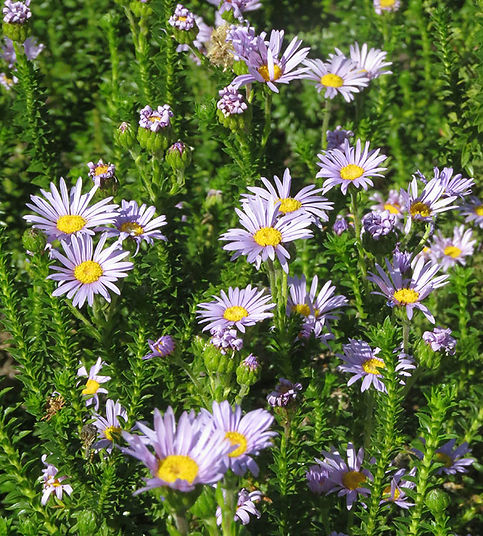Felicia echinata
Water Needs
low; moderate water wise

Perennial
Dune Daisy, Prickly Felicia, or Bloublommetjie
60 cm
Size
Light Conditions
sun
Frost
tneder
Flowers
Mauve and white; April to October; autumn winter spring
Garden Situation
sun; container; rockery; shrubbery; walls; sandy soils; salty air; windy exposed; urban streets; paving; clay soils;
Habitat
rocky places; fynbos; urban streets
Region
western cape; thicket
Rain Season
winter
Find informative indigenous gardening articles in our web magazine - www.theindigenousgardener.co.za
Description
The attractive mauve Dune Daisy, Prickly Felicia, or Bloublommetjie, begins its long flowering season in April, continuing right through to mid-spring. Frequenting road edges and sand dunes in its distribution range of the Eastern Cape (Mossel Bay to Port Alfred,) the Dune Daisy adds soft colour and texture to the winter garden. It is a multi-branched shrublet with a rather neat and compact growth form in gardens reaching a mature size of 60 cm. Flowers are pale mauve, brightened by the egg yellow centres, and they form large clusters of 2-4 flowers at the tips of the branches, with faces tilted towards the sun. Stems are relatively uniform in length so the flowers all appear at much the same level. Leaves form a thick cover along the entire stem and are most attractive; glossy dark green, triangular to oval in shape, with lower ones recurving downwards, and edged with fine serrations. Flowers give way to soft and fluffy seed heads light enough to be wind dispersed, but, ensure that you leave a few flowers to set seed. Birds will use them to line nests, and, if allowed to germinate, will produce fresh plants the following season – a good idea as plants are past their prime after 3-4 years. For those with small gardens, the Dune Daisy is a better choice than the rambling Dimorphotheca daisies that can take over small beds rapidly. Plant this gorgeous daisy in open, sunny areas where soils drain well, from a perennial border to pots, rockeries, or part of a small shrubbery. It is a good choice in sandy or poor soils, is water-wise, wind and salt tolerant, but frost tender. Prune back by a third at the end of autumn, or when flowering is over. In Kirstenbosch, they mix beautifully with a variety of other species; aloes, other succulents like vygies, Ocimum labiatum (= Orthosiphon labiatus), Cineraria saxifraga, Dissotis species. They would combine beautifully with blue flowering plants, like Aristea and Agapanthus, or dark purple groundcovers like Geranium incanum. A white variety is occasionally found in the wild, and has now been cultivated, and should be available at specialist nurseries.




